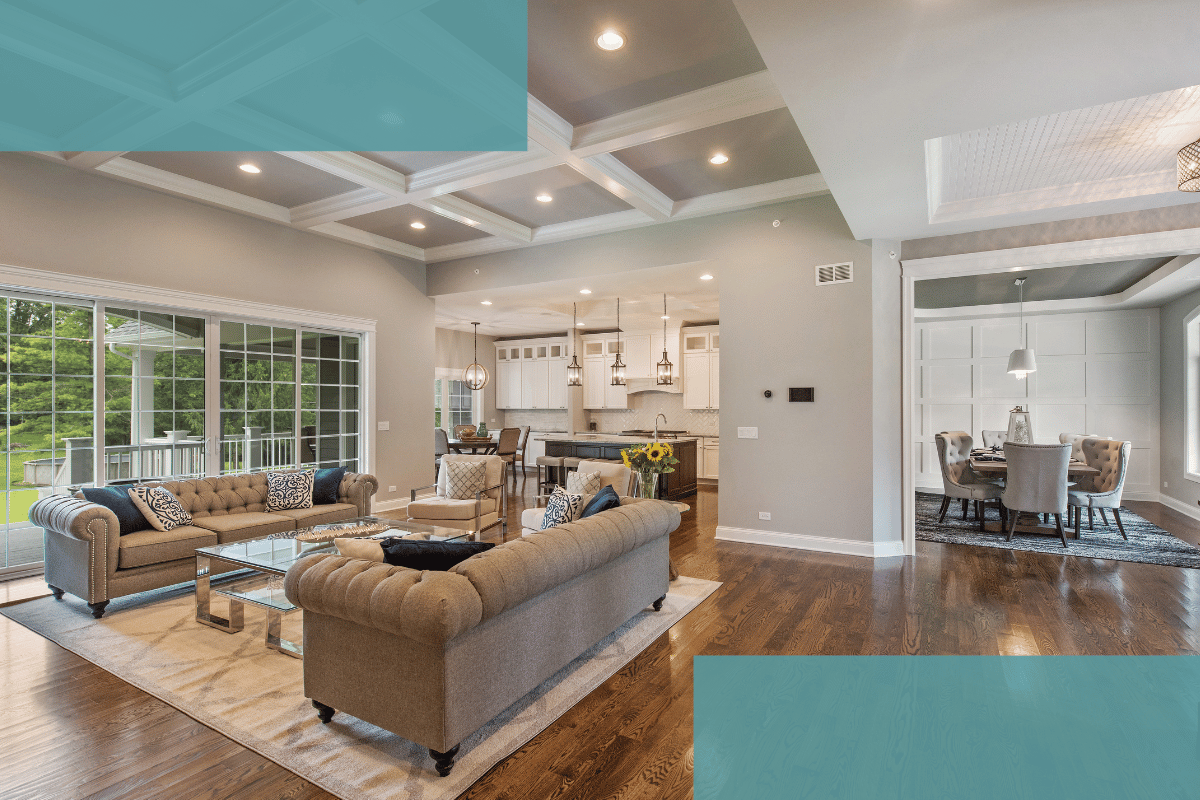Open-concept homes have been a popular trend for years, and it’s easy to see why. They create a sense of spaciousness, improve flow, and make it easier to keep an eye on kids while you’re in the kitchen or living room.
With fewer walls, the space feels more connected and airy. But here’s the challenge: while open floor plans can feel liberating, they also present a problem.
With fewer walls, it can be hard to define each area for its specific function. You might want the kitchen to feel separate from the living room, or you might want to create a cozy reading nook without it feeling like it’s just part of the hallway. The key is to figure out how to create boundaries in open-concept spaces without completely closing off the area.
In this article, we’ll explore practical and creative ways to define your spaces while maintaining the openness and flow that makes your home feel inviting.
Arrange Your Furniture
One of the easiest and most effective ways to define spaces in an open-concept home is by thoughtfully arranging your furniture. It might seem like a small adjustment, but the way you place your pieces can create a clear sense of separation without the need for walls or heavy partitions.
Face Your Furniture Away from High-traffic Areas
If your living room is next to your kitchen or dining area, try positioning your sofa or sectional so that it faces away from the kitchen. This simple change helps to create a sense of separation between the spaces while still maintaining the openness of the room.
Turning the furniture this way can make the living area feel distinct and cozy, signaling that it’s a space for relaxing, while the kitchen remains a separate zone for cooking or socializing.
Use Taller Furniture to Divide Spaces
You can also use taller furniture pieces to break up your open-concept space. A console table, bookshelf, or a tall piece of storage furniture can act as a visual divider between rooms without closing anything off.
For example, a bookshelf placed between the living and dining areas provides storage and also adds structure to the space. The key is to choose furniture that doesn’t overwhelm the room but subtly adds separation.
Add Height with Decorative Items
If you go with a console table or a similar piece, placing taller items on top—such as table lamps, a tall vase, or a piece of art—can help emphasize the boundary between areas. These items won’t block the light but add just enough height to visually separate the spaces without making the room feel crowded or closed off.
Use Rugs to Create Boundaries
Another great way to define areas in an open-concept home is by using rugs. While they might not be the first thing that comes to mind when you think about creating boundaries, area rugs can work wonders in visually separating different zones of your home.
Rugs as Invisible Walls
Area rugs act like invisible walls, helping to “zone” your space and create clear divisions between rooms. For example, placing a rug under the living room seating area helps set it apart from the dining space, even if the two are in close proximity. Rugs add texture, color, and structure to an open floor plan, giving each area a distinct feel while still maintaining that airy, open-concept vibe.
Choosing the Right Size Rug
It’s important to choose a rug that’s the right size for the space. A rug that’s too small will make the area feel disconnected, while a rug that’s too large can overwhelm the room and blur the lines between different zones. Ideally, pick a rug that’s large enough to fit under the main pieces of furniture in each area. For the living room, that means placing a rug that comfortably fits the sofa and coffee table.
Read more: What to Look for When Buying an Area Rug
Float Your Furniture
Floating your furniture is another simple yet effective trick. This means arranging your furniture away from the walls and placing it more centrally in the room, which helps to break up the open space and create distinct zones without blocking the flow.
Why Floating Furniture Works
When you pull your furniture away from the walls, it not only creates a sense of separation but also helps to balance the space. In an open-concept layout, everything can start to feel too “open” and a bit chaotic if there’s nothing anchoring each area.
Floating your furniture allows each piece to have its own presence in the room while still keeping the space connected. It’s a subtle way to mark the boundaries between your living, dining, and other areas without making the room feel crowded or closed off.
For example, in the living area, you might place your sofa or sectional a few feet away from the wall, with a coffee table in front of it. This creates a clear zone for lounging while still leaving plenty of open floor space around it. In the dining area, try positioning the table more centrally within the space, instead of against the wall, to give it its own area without feeling boxed in.
When furniture is floated, it naturally allows for more movement and flow around the room. This arrangement can help visually separate the areas while still maintaining the openness that makes your home feel spacious. You can even pair this layout with other elements like lighting to define the zones further. For example, a light fixture hung directly over a dining table or living area can signal that these are distinct spaces within the open concept.
Read more: The Art of Floating Furniture: Creating Open Spaces Around Window Walls
Use a Folding Screen or Decorative Divider
A folding screen or decorative divider can be another stylish and practical solution. These pieces not only offer separation but also add character to your home, all while keeping the space feeling open and airy.
If you need more defined separation between spaces but still want to maintain the open feel of your home, a folding screen can do the job. It’s perfect for when you want to create a little privacy or visually separate areas like the living room and dining room, or even a home office nook within a larger space.
A folding screen offers flexibility because it’s not permanent—if you ever want to change things up, you can simply move it to another part of the room or take it down completely.
If you’re looking for something that adds more design flair, a decorative divider can work just as well as a folding screen. These dividers come in all sorts of materials, from wood to metal to fabric, and can be used to break up spaces while also serving as a unique decorative element in your home. Decorative dividers tend to be a bit more permanent than folding screens, but they still allow light to flow through and keep the space feeling open.
Affordable and Flexible
One of the biggest benefits of both folding screens and decorative dividers is their affordability. Unlike building walls or installing permanent partitions, these pieces are relatively inexpensive and require no heavy installation. They also give you the flexibility to rearrange or move them to different spaces as your needs change. If you want to shift the layout of your home or change how areas are defined, these dividers offer a low-effort solution.
Match the Décor for Both Spaces
Whether you opt for a folding screen or a decorative divider, it’s important that the piece complements the décor of both areas you’re trying to separate. If you’re using it between a modern living room and a more traditional dining room, try to find something that balances both styles. A simple, neutral design can often work best, but you can also use bold patterns or textures for a more dramatic look. The key is to make sure the piece feels like it belongs to both spaces, blending seamlessly with the overall design of your open-concept home.
Use Plants
Plants are more than just a way to bring a touch of nature indoors. They can also help create boundaries in an open-concept home without making the space feel closed off. With the right plants, you can visually separate areas and add life to your home all at once.
One of the simplest and most stylish ways to break up an open-concept space is with large, leafy indoor plants. A tall tree or a group of plants can serve as a natural divider between areas like the living room and dining area, or even separate a cozy reading nook from the rest of the space. The greenery softens the transition between different zones while still allowing light to flow through, so the room remains bright and open.
Choose Pet-Safe Plants
If you have pets, it’s important to choose plants that are safe for them. Many common houseplants, like lilies, can be toxic to animals if ingested. Fortunately, there are plenty of pet-friendly options that not only look great but are also safe for your furry friends.
Some popular pet-safe plants include spider plants, bamboo palms, and calatheas. Before adding plants to your open-concept space, make sure to double-check that the ones you choose won’t harm your pets. You can use this link to check if a plant is toxic to pets.
Create Green Zones
Plants also help create a calm, relaxing atmosphere. By using plants to divide areas, you can create a feeling of a “green zone,” where each space feels inviting and comfortable. Grouping plants of different heights and textures can add depth to your layout, making each area feel more intentional and defined. Plus, taking care of plants can become a rewarding hobby that connects you even more with your living space.
Read more: The Many Benefits of Indoor Plants
There are plenty of ways to create separate spaces in your open-concept home without closing off the flow. You have a variety of options to help define areas while still keeping the openness that makes your space feel inviting and spacious.
The key is to find what works for you and your family’s needs. What works for one home might not be the right fit for another, and that’s perfectly okay. We understand that while it may seem like a simple task, figuring out the best way to define your zones can feel daunting.
Our interior design experts are here to help make the process as easy and enjoyable as possible. Whether you’re looking for practical advice or full design assistance, we’ll guide you every step of the way to create a home that flows beautifully and works for you.
We’re proud to offer complimentary interior design services for homeowners in Lafayette, Alexandria, Pineville, and the surrounding areas. Ready to get started? Simply fill out our online form to book your free consultation today.

